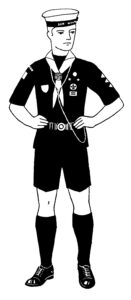Ceremonies and Traditions
To Sea Scouts the Troop meeting place is their ship; the floor becomes the deck, the walls bulkheads and ship’s sides, the ceiling the deck-head, the Leader’s room the Wardroom, the main entrance the main gangway, and so on. This creation of a nautical atmosphere is an important part of Sea Scouting and many of the customs and traditions at Sea Scout meetings stem from the life at sea.
As nearly as possible the main deck should be made to represent the deck of a vessel. The kind of vessel will depend on the decision of the Group Council and the extent to which the Troop has use of the premises. Some Troops fit the main deck up with a replica of a bridge, complete with ship’s wheel, binnacle and compass, etc., but it is well to consider in the planning the extent that such permanent structures will encroach on the available space.
Gangway stanchions can be let into the deck with man ropes rove between them to mark off an area for the Quarterdeck, and it is possible to make up a realistic binnacle with a ship’s wheel and a mast complete with yard and gaff, but which is also portable so that the deck can be cleared for games at “Stand easy”. If it is not advisable to bore holes in the deck for the stanchions they can easily be made up of heavy water pipe set in solid bases so they will stand without further support but are still easily removed.
As the Sea Scouts step on board over the main gangway they salute the Quarterdeck, thereby carrying out a custom of the sea that began centuries ago.
Sea history tells us that before the Reformation many of the great ships, particularly those of Spain and England, erected small crucifixes on the after part of the ship, and men passing by the crucifix saluted. Today all naval officers and men are required to salute upon coming aboard the vessel. The Officer of the Day returns all salutes. The Patrol Leader of the Duty Patrol or Duty Watch will tell off one of his Scouts to stand as Quartermaster at the main gangway to receive all visitors and conduct them to the Ward room and to acknowledge the salutes of all those boarding the ship.
The Boatswain’s call is used throughout the meeting to call the Troop to muster and to “pipe up” the Colours. Colours are usually made at 0800 hrs and struck at sunset, but as Troop meetings usually take place in the evenings, Sea Scouts make Colours at the start of the parade, and they are struck at the end of the evening.
Side party is the term applied to a detail of Sea Scouts which falls in on the gangway as a Guard of Honour to receive distinguished visitors.
The tradition of having a side party in the ceremonial originated in the custom of posting a guard to keep unwelcome visitors from coming on board the ship, and for ceremonial purposes to form a Guard of Honour for important visitors.
In some Troops two or more Patrols may be formed into Watches either for games, competitions, instructions, etc. This is purely a local arrangement, and it should not be forgotten that the Patrol is our basic unit.
There are many sea customs, but only those included in the Sea Scout programme are dealt with in this Handbook. Leaders should note that further additions to Troop ceremonial are to be discouraged.
The origins of many of these customs have interesting histories in themselves, and it is as well for Sea Scouts to have some knowledge of how the customs they observe developed.
The Ensign, Flags and Dressing Ship
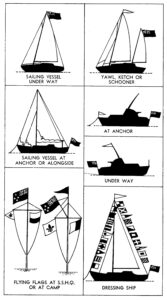 In the days of Charles II, a fleet of King’s ships might number up to as many as 200 sail, and these were divided into three squadrons. The squadron in the centre flew the Red Ensign, and the Admiral in Command wore the Union Flag at the main, the squadron in the van flew the White Ensign, and the Vice Admiral had the Union Flag at the fore, the squadron in the rear flew the Blue Ensign, and the Rear-Admiral flew the Union Flag at the mizzen. Thus it could be told to which squadron a ship belonged by a glance at her ensign.
In the days of Charles II, a fleet of King’s ships might number up to as many as 200 sail, and these were divided into three squadrons. The squadron in the centre flew the Red Ensign, and the Admiral in Command wore the Union Flag at the main, the squadron in the van flew the White Ensign, and the Vice Admiral had the Union Flag at the fore, the squadron in the rear flew the Blue Ensign, and the Rear-Admiral flew the Union Flag at the mizzen. Thus it could be told to which squadron a ship belonged by a glance at her ensign.
This system continued for many years, but it had its drawbacks, as a number of different ensigns in battle tended to cause confusion.
As ships got larger numbers became fewer, and the three Colours became less important, while foreigners sometimes had difficulty in understanding the changes of ensign. Therefore, in 1864, Queen Victoria gave orders that in future the White Ensign should be flown by all ships of war, the Blue Ensign by ships commanded by officers of the Royal Naval Reserve after receiving special permission from the Admiralty, and the Red Ensign by all other British ships, and thus it remains today. Actually, the White Ensign is also flown by Royal yachts and yachts belonging to the Royal Yacht Squadron. Both the White and Blue Ensigns come under Admiralty control, and the Red too, if it is “defaced”, that is, if it carries some device in addition to the Union Jack and may only be flown by the holding of a personal warrant (or permission) from the Admiralty. The Blue Ensign defaced, or the Red Ensign defaced may be flown in peacetime by members of certain yacht clubs who hold personal warrants, and the Blue Ensign defaced by ships belonging to certain Government departments. The personal warrant must be carried, and the captain of any warship has the right to send an officer aboard in addition, when the owner is not aboard to examine it; in addition, when the owner is not aboard the Red Ensign must be flown.
The correct position for the ensign in power-driven craft is from the ensign staff aft when at anchor, and from the ensign staff or at the peak of the gaff when under way. In sailing craft, it should be flown from the ensign staff when at anchor and at the peak when under way.
The correct time to hoist Colours when in port is at 0800 hrs, the Colours being lowered at sunset. When at sea the ensign should always be flown, and on getting under way after sunset it should be hoisted if there is light enough to see it.
When a merchant ship or a yacht meets a warship she should salute by dipping her ensign; that is, she should slowly lower the ensign, keeping the halyards taut, and keep it dipped until the warship has answered by dipping hers and hoisting it again.
If a ship enters a foreign port as a courtesy gesture she may fly the ensign of that country from the masthead, wearing, of course, her own ensign aft.
As a sign of national mourning the ensign should be flown at half-mast; if it has not been hoisted previously it should first of all be hoisted close-up and then lowered to half-mast, while to lower an ensign from half-mast it is first hoisted close-up and then lowered. Various reasons have been given for this custom, and one interesting suggestion is that the ship has been overcome by death, and that his invisible flag is supposed to be flying above the half-masted ensign. Another more probable reason is that it is just a mark of respect.
A national flag hoisted upside down is a signal of distress, and indicates that assistance is required, while to hoist another nation’s flag upside down is an insult, so care should be taken that it is always hoisted correctly.
If a ship is seen with the ensign of one country flown above that of another on the same mast, it means that the ship has been captured by the country whose ensign is on top. This is the only occasion when two flags used as Colours may be flown on the same halyard.
Sea Scouts are principally concerned with the use of flags as ensigns or signals. A knowledge of the correct usage in respect to flags is an essential of good seamanship, since flags are used more extensively at sea than on land.
Girls and boys coming into a Sea Scout Group knows little about flags other than the New Zealand Flag or the Union Flag. The Troop is a good place for them to commence learning something about ensigns and signals and the correct use of them.
The New Zealand Flag, known as the New Zealand Ensign, is the only flag which may properly be flown from a masthead or flag-staff ashore.
The New Zealand Navy Ensign used to be the British White Ensign but in 1968 both Australia and New Zealand introduced their own distinctive ensign.
The Union Jack in the upper hoise canton and the stars of the Southern Cross in the lower fly canton, the Australian flag having the additional Commonwealth Stars. The stars are red on a white ground, for the New Zealand Ensign and blue for the Australian.
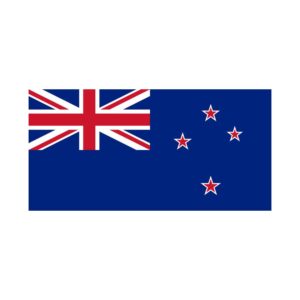
The New Zealand Red Ensign is the proper national Colour for New Zealand merchant ships, yachts and other small craft. Certain yacht clubs and government owned ships wear the Blue Ensign. The distinguishing flag of a yacht club is the Pennant, and is worn by members of it, or, in the case of Sea Scouts, of the Troop concerned. Merchant ships also wear their company house flag from the main mast.
Since most Sea Scout Troops use their headquarters as the deck of a ship in harbour, we may make use of the nautical etiquette of flags and wear a blue ensign as our proper national Colours.
Flags are made of wool bunting or nylon, and it is correct to call all flags “bunting”. In conversation and when giving orders remember the following: A flag is “worn”, not “flown”; a flag is “made”, not “hoisted”; a flag is “struck”, not “hauled down”. Bunting is made flying free and not broken out as in the case of the New Zealand Flag ashore. When making Colours they are to go up smartly, when striking they come down slowly.
The Boatswain’s Call
In the fifth century B.C. the Grecian Navy was rising to fame, their vessels being manned by large numbers of men in the rowing galley. The chief difficulty was to see that the men rowed in unison, and the only way that this could be done was to have some signal which could be heard all over the ship.
The instrument used in the Greek Navy was the flute, or whistle, and the oarsmen knew exactly what to do when each sound was played. So far as we know, this was the method used later in the Roman Navy and all other navies up to the time of Christ. Curiously enough, from the fall of the Roman Empire and all through the dark ages, very little is known of the history of this whistle.
During the reign of Edward I of England, from 1272 to 1307, it is stated that the man in charge of the rowers for each stroke of the oar with the whistle. The next reference to the whistle is mentioned in 1417, where a record is found that Stephen Thomas, Master of H.M.S. Trinity Royal bequeathed his whistle to his successor, Thomas Cheese. During the next hundred years this whistle increased in importance because later mention is made of it in 1513 when the Lord High Admiral of the British Fleet, Sir Edward Howard, received a gold whistle and chain from the Queen in recognition of his victory in the attack on the galleons of France at Brest. It was called the “Whistle of Command” and the wearer was recognised as having a special commission from the Sovereign of the country. From then on it came to be the mark of the Admiral of the Fleet.
In 1532 Henry VIII decreed it the mark of the Master of a vessel. The law was actually written this way— “Master of the ship or other vessel shall wear a whistle of silver with a chain of silver to hang same upon.”
As ships were built larger, the silver whistle was worn by the Mates, and as the ships became larger still it was worn by the Boatswain’s Mate, and still is in all the navies in the world. Although it has lost its designation as being the whistle of command and worn by the Commander, it is now recognised as the instrument by which the orders of the Commander are passed to the crew.
The expression “To pipe” means generally to sound the Boatswain’s call and to give the spoken order which may qualify it. Many pipes, however, are orders in themselves and do not require any verbal addition afterwards; for instance, it is unnecessary to call “Hands to dinner” after the pipe “Dinner”, even supposing you had enough breath left to do so after having made the pipe.
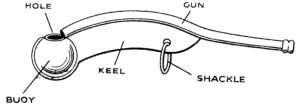
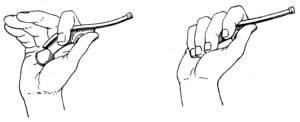
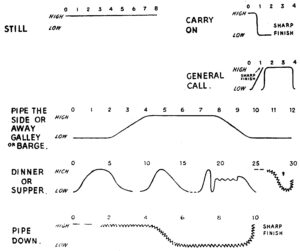
There are two main notes, the “low” and the “high”, and three tones “steady”, and “warble” and the “trill”.
The plain low note is produced by blowing steadily into the mouth of the gun with the hole of the buoy unobstructed by the fingers. The plain high note is produced by closing the fingers round the buoy, taking care not to touch the edges of the hole. The warbel is produced by blowing in a series of jerks, which results in a warble similar to that of a canary.
The trill is produced by vibrating the tongue while blowing, as in rolling the letter “R”.
“Dinner” is used to call the hands for a meal.
“Still” is used to call the hands to attention for the hoisting or lowering of Colours and as a mark of respect, or to stop all work to prevent an accident. It is followed at the required interval by the “Carry on”.
“Lash up and stow” precedes the calling on the hands in the morning.
“Pipe down” means “Hands turn in”.
“General call” precedes any routine order, and the pipe is followed by a verbal order. For Troop use at H.Q. or Camps this pipe would precede the calling away of the boat, or a particular Patrol crew, or a particular Scout, or to precede the call “Troop, Fall in” on parade nights. When the pipe precedes general information call, “D’ye hear there?” before calling the information, e.g. “The camp mailbox will be cleared at 11 a.m.” or “The D.C. will be visiting the ship today”. In most Troops the Senior Patrol Leader wears the Boatswain’s call on his lanyard.
Time Aboard Ship
“Strike the bell eight.”
It would be difficult to estimate the number of times this order has been given for striking the bells on board ships to denote the passing of time. Long before the dawn of the Christian era men had gone to sea in ships, and even prior to that men have sailed on the inland waters of the great continents. The very earliest records of China depict stories of Chinese ships travelling up and down its great rivers.
Clocks as we know them now were not invented until the fourteenth century. However, there were various ways of approximating time in the old days, including the sundial, the water clock, and the hourglass. On board ship it was not possible to use the sundial or the water clock because they called for a solid foundation and steadiness. So it was necessary to use the hour glass for denoting the passage of time. History indicates that in the early days, on large ships the emptying of the sand from the upper to the lower half of a so-called hourglass was announced by the striking of a gong in the central part of the ship.
Before the use of sails the passage of time was extremely important to the poor slaves in the days of the slave ships of Assyria and Egypt, and even in the time of the Romans and Greeks. It requires no stretch of the imagination to appreciate how welcome the sound of the gong must have been to the slaves who manned the oars of the biremes and triremes, the two and three-banked rowing crafts of the Greeks, Romans, and Carthaginians. They must have enthusiastically welcomed the sound of the gong informing them of the passing of time and approach of a rest period from their backbreaking work at the oars. The alternate work and rest periods were of variable duration, depending upon prevailing conditions. Certainly, less time was spent rowing against the wind and tide than when rowing with these elements.
In these very early days, sand passed from one half of the glass to the other in approximately one half-hour, and a normal turn at the oars consisted of two shifts of the glass, that is, one hour of time. The gong was struck once at the end of the half hour, and twice at the end of the hour.
When the use of auxiliary sails came into being, the spell at the oars was extended over a longer time—four turns of the glass. This period was indicated by striking the gong four times, with an interval between the second and third strikes. When sails entirely superseded oars, the length of time the crew were on watch (on duty) was extended up to eight turns of the glass, which corresponds to the present length of a watch, namely, four hours. Today these watches are indicated by the making of the ship’s bell at half-hour intervals, thus making a total of eight bells for each watch. (It is common practice in Sea Scout Groups to make ship’s bells throughout the meetings.)
The passage of time on board ship is now indicated by bells almost universally. It is interesting to note that official time on board English naval vessels was recorded by hour glasses as late as the year 1859 in spite of the fact that all other nations had long since been using clocks.
Today the day of 24 hours is divided into seven watches, and the three different methods of describing them are as follows:
| Sea Time | Civil Time | Watch |
| 0001 to 0400 | midnight to 4 a.m. | middle watch |
| 0400 to 0800 | 4 a.m. to 8 a.m. | morning watch |
| 0800 to 1200 | 8 a.m. to noon | forenoon watch |
| 1200 to 1600 | noon to 4 p.m. | afternoon watch |
| 1600 to 1800 | 4 to 6 p.m. | first dog watch |
| 1800 to 2000 | 6 to 8 p.m. | last dog watch |
| 2000 to 2400 | 8 to midnight | first watch |
The purpose of the two dog watches is to make an odd number of watches in the 24 hours, thus giving the men different watches each day.
Time is denoted on board ship by striking a bell every half hour, the rule being: one stroke of the bell at half past four, half past eight and half past twelve, one more stroke being added for each half-hour until eight strokes of the bell or eight bells are reached at four, eight, and twelve. The dog watches are different, 6.30 p.m. being one bell, 7 p.m. two bells, and 7.30 p.m. three bells, but eight o’clock is always eight bells. “Little one bell” is a light stroke struck five minutes before beginning of the night watches and calls the relieving watch to muster.
Why no striking of five bells in the last dog watch? Well, in 1797, five bells was the signal for the Navy mutiny at the Nore. The plot was discovered, and the mutiny quelled, and thereafter the Admiralty decreed that five bells in the last dog watch should never again be struck in British vessels.
Sea Scout Uniform
The uniform for Sea Scouts is described in P.O.R.
The purpose of the uniform, of course, is to single you out as a member of a special Group, to mark you as one of the fine people of the world. The public always recognise this significance, and in the case of a Scout uniform knows that the wearer is a member of the Scout Association of New Zealand. and that same public knows that a Scout has a special way of living—that they can expect from them courtesy thoughtfulness, honesty, and help. Of course, the mere wearing of the uniform will not give you these qualities, but the very fact that you wear it should keep you aware of what is expected.
It is a privilege to wear the Scout uniform, but it is also a responsibility. Anything you do while wearing it reflects upon all Scouts. So, it becomes your responsibility to keep your uniform correctly creased, cleaned, and cared for.
